Here they are, ranked by how much weight we put behind them:
from Social – TechCrunch https://ift.tt/2Pc5Z51
via IFTTT
A place where you can share and benefit the digital marketing &technology experience with an emphasize on the Middle-east and Egypt
Go to Blogger edit html and find these sentences.Now replace these sentences with your own descriptions.This theme is Bloggerized by Lasantha Bandara - Premiumbloggertemplates.com.
Go to Blogger edit html and find these sentences.Now replace these sentences with your own descriptions.This theme is Bloggerized by Lasantha Bandara - Premiumbloggertemplates.com.
Go to Blogger edit html and find these sentences.Now replace these sentences with your own descriptions.This theme is Bloggerized by Lasantha Bandara - Premiumbloggertemplates.com.
Go to Blogger edit html and find these sentences.Now replace these sentences with your own descriptions.This theme is Bloggerized by Lasantha Bandara - Premiumbloggertemplates.com.
Go to Blogger edit html and find these sentences.Now replace these sentences with your own descriptions.This theme is Bloggerized by Lasantha Bandara - Premiumbloggertemplates.com.
Here they are, ranked by how much weight we put behind them:
Hillsborough State Attorney Andrew Warren announced today that he has filed 30 felony charges against a 17-year-old resident of Tampa, Florida, who was described by the state attorney’s office as “the mastermind of the recent hack of Twitter.”
The hack in question occurred earlier this month and involved high-profile Twitter users like Apple, Elon Musk, Joe Biden and Barack Obama, whose accounts all posted messages promoting a Bitcoin wallet and claiming, “All Bitcoin sent to the address below will be sent back doubled!”
The teen (we’re not identifying them because they’re a minor) allegedly made more than $100,000 through this cryptocurrency scam.
The state attorney’s office said that the teen was arrested earlier today as a result of an investigation by the Federal Bureau of Investigation and the U.S. Department of Justice, and that they will be tried as an adult. They face charges including one count of organized fraud (over $50,000) and 17 counts of communications fraud (over $300).
“These crimes were perpetrated using the names of famous people and celebrities, but they’re not the primary victims here,” Warren said in a statement. “This ‘Bit-Con’ was designed to steal money from regular Americans from all over the country, including here in Florida. This massive fraud was orchestrated right here in our backyard, and we will not stand for that.”
As we reported at the time, the hack used Twitter’s own admin tool to gain access to high-profile accounts. The company just updated its blog post outlining what it knows about the attack:
The social engineering that occurred on July 15, 2020, targeted a small number of employees through a phone spear phishing attack A successful attack required the attackers to obtain access to both our internal network as well as specific employee credentials that granted them access to our internal support tools. Not all of the employees that were initially targeted had permissions to use account management tools, but the attackers used their credentials to access our internal systems and gain information about our processes. This knowledge then enabled them to target additional employees who did have access to our account support tools. Using the credentials of employees with access to these tools, the attackers targeted 130 Twitter accounts, ultimately Tweeting from 45, accessing the DM inbox of 36, and downloading the Twitter Data of 7.
To prevent a similar attack from succeeding in the future, Twitter said it will be “accelerating several of our pre-existing security workstreams and improvements to our tools” and also improving the methods it uses to detect and stop inappropriate access to its internal systems.
Facebook today confirmed it will begin rolling out official music videos across its platform in the U.S., as TechCrunch first reported, as well as introduce a new Music destination within Facebook Watch. The changes, which will go into effect starting this weekend, will allow Facebook users to discover, watch and share music videos from a wide range of artists, including, for example, Anitta, Blake Shelton, Bob Marley, Diplo, Elton John, Jonas Brothers, Josh Groban, Keith Urban, Maren Morris, Marvin Gaye, Miley Cyrus, Nicki Minaj, and others.
Though Facebook had already been working with partners in India and Thailand on a similar music experience before today, the U.S. launch is enabled by Facebook’s expanded partnerships with top labels, including Sony Music, Universal Music Group, Warner Music Group, Merlin, BMG, Kobalt and other independents.
Facebook tells TechCrunch its deals include the full catalog across all major partners and a host of independents.
TechCrunch earlier this month reported Facebook’s plans for music videos would arrive August 1st. We also noted that supported artists were being informed they would soon need to toggle on a new permission that would allow Facebook to automatically add their music videos to their Page, where they could be discovered by fans on the Page’s Videos tab. Once enabled, the artists will be able to edit or remove their video posts at any time.
However, if this setting was not enabled, Facebook will instead automatically generate a separate official music Page on the artist’s behalf, titled “[Artist Name] Official Music,” to enable discovery. That Page would be created and controlled by Facebook and accessible through Facebook Watch, though artists can later choose to opt-in to include their official videos on their own Page.
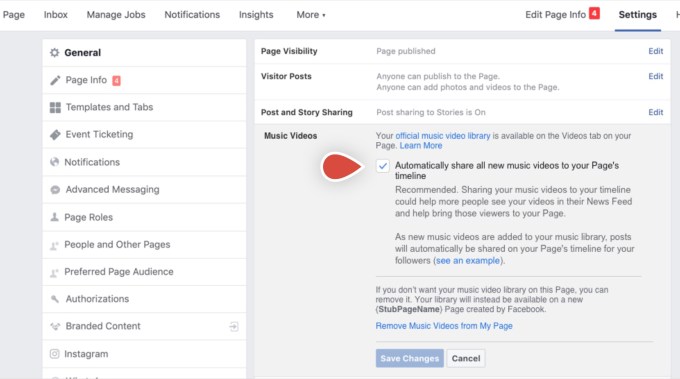
Image Credits: screenshot via TechCrunch
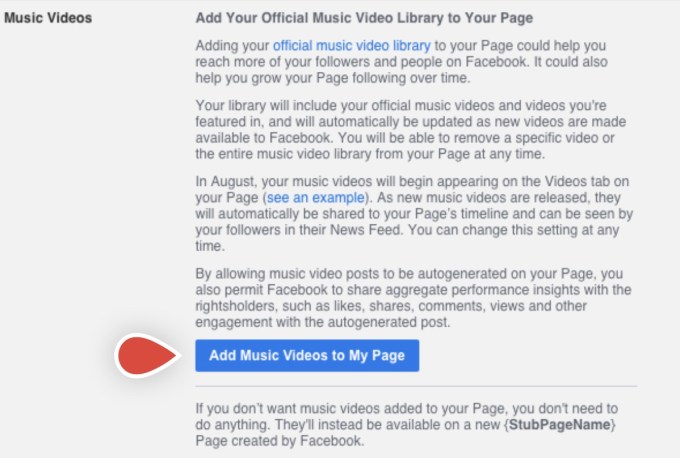
Image Credits: TechCrunch
With the launch, Facebook users will be able to follow their favorite artists, then receive the latest music video releases from those artists in their News Feed, as they go live. The “follow” option will be available not only on the artist’s Facebook Page, as before, but also directly from the music videos themselves.
By clicking through on the shared posts, fans will be directed to the artist’s Facebook Page, where they can browse the Videos tab to watch more officially licensed music.
The music video posts, like any on Facebook, can be shared, reacted to and commented on. They can also be shared across News Feed, where friends can discover the posts, as well as shared to Groups and in Messenger.
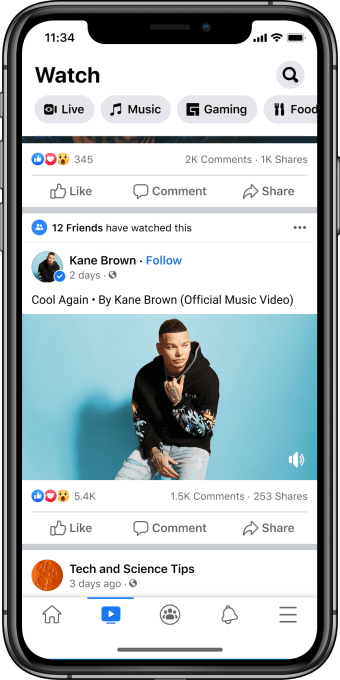
Image Credits: Facebook
The dedicated Music section on Facebook Watch, meanwhile, will allow users to explore music by genre, artist name or mood, or across themed playlists like “Hip Hop MVPs,” “Trailblazers of Pop,” “Epic Dance Videos” or more timely playlists like “Popular This Week” and “New This Week.”
The videos will also be monetized by advertising, like elsewhere on Facebook Watch. However, unlike some video ads, they won’t interrupt the music in the middle of playing. Instead, Facebook tells TechCrunch the ads will either appear pre-roll, during the video as an image ad below the video player or post-roll. These plans may change in the weeks ahead as it iterates on the experience, Facebook notes.
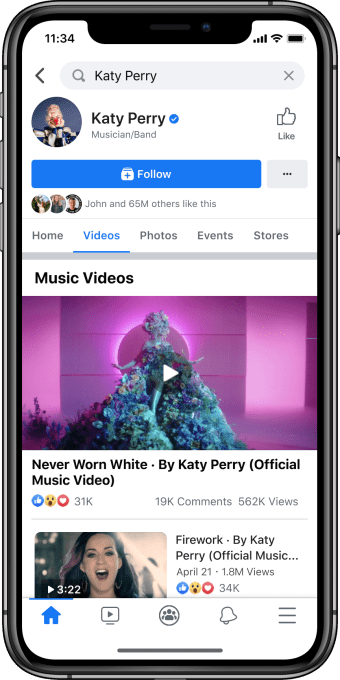
Image Credits: Facebook
The company will apply its personalization technology to the music video experience, too, we understand. As users watch, engage and share, the Music destination in Facebook Watch will become more attuned to your personal likes and interests.
More social experiences are planned for the future, including user-generated playlists.
“Official music videos on Facebook are about more than just watching a video. They’re about social experiences, from discovering new artists with friends to connecting more deeply with artists and people you love,” said Facebook VP of Entertainment, Vijaye Raji. “There’s something in our music video catalog for everyone, and we’re excited for people to discover and rediscover their favorites,” he added.
Facebook says this weekend’s launch of the new Music experience is just the start, and it plans to roll out more music across the platform over time.
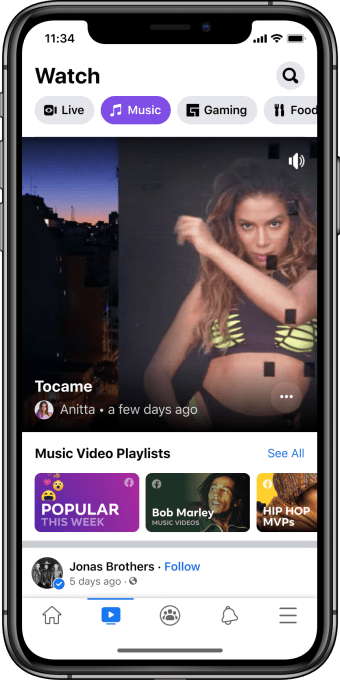
Image Credits: Facebook
Facebook’s launch of music videos is seen as a significant challenge to YouTube, which accounted for 46% of the world’s music streaming outside of China as of 2017, according to a report from IFPI. YouTube, around that time, also claimed more than 1 billion music fans came to its site to connect with music from over 2 billion artists.
More recently, YouTube reported it had paid out more than $3 billion to the music industry in 2019. The music labels, however, have shown interest in an alternative to YouTube, which they feel doesn’t pay enough. The financial terms of Facebook’s deal with the labels were not disclosed.
Though Facebook had deals with music labels before now, those were more limited. Artists from major labels, for example, weren’t able to share full music videos due to licensing rights — they could only post a short preview. The change to include full videos could significantly impact how much time users spend on Facebook in the months ahead.
The launch follows a month-long Facebook advertiser boycott over issues around hate speech on the platform, which some brands have chosen to continue with, reports say. But the music video launch was not timed to encourage an advertiser return. According to documents previously reviewed by TechCrunch, the date of August 1, 2020 had been the planned launch date for some time.
The videos are now one of several ways artists can connect with fans on Facebook, as the company had already rolled out tools that allowed artists to promote new releases with custom AR effects and Music Stickers, host live-streamed Q&As on Facebook Live and raise money for important causes through the donate button in Live and Stories.
“Artist/Fan connection on Facebook is deeper and more authentic because of tools like Stories, Live and custom AR effects. Official music videos are re-born in that setting — they become part of the way people express identity and mood and bring a new dimension to the artist storytelling that happens on our apps every day,” said Tamara Hrivnak, VP of Music Business Development and Partnerships at Facebook.
Twitter has confirmed it has permanently banned the account of David Duke, former leader of white supremacist hate group the Ku Klux Klan.
Duke had operated freely on its platform for years — amassing a following of around 53k and recently tweeting his support for president Trump to be re-elected. Now his @DrDavidDuke account page leads to an ‘account suspension’ notification (screengrabbed below).
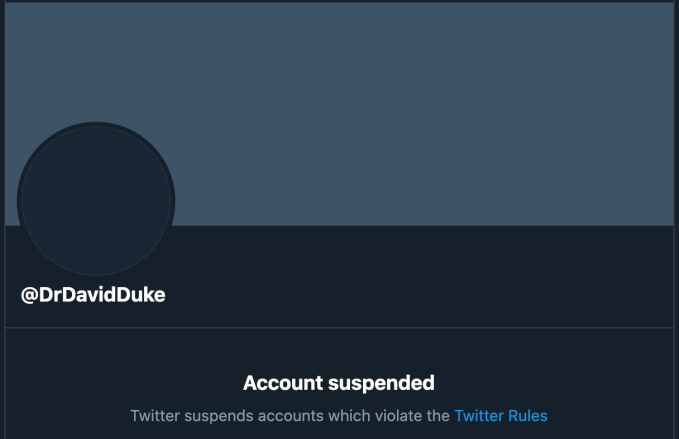
A Twitter spokesperson confirmed to TechCrunch that the ban on Duke is permanent, emailing us this brief statement:
The account you referenced has been permanently suspended for repeated violations of the Twitter Rules on hateful conduct. This enforcement action is in line with our recently-updated guidance on harmful links.
While the move has been welcomed by anti-nazis everywhere, no one is rejoicing at how long it took Twitter to kick the KKK figurehead. The company has long claimed a policy prohibiting hateful conduct on its platform, while simultaneously carrying on a multi-year journey toward actually enforcing its own rules.
Over the years, Twitter’s notorious passivity in acting on policy-defined ‘acceptable behavior’ limits allowed abuse and toxic hate speech to build and bloom essentially unchecked — eventually forcing the company to commit to cleaning up its act to try to stop users from fleeing in horror. (Not a great definition of leadership by anyone’s standards as we pointed out back in 2017.)
Roll on a few more years and Twitter has been slowly shifting up its enforcement gears, with a push in 2018 toward what CEO Jack Dorsey dubbed “conversational health“, and further expansions to its hateful conduct policy. Enforcement has still been patchy and/or chequered. But appears to have stepped up markedly this year — which kicked off with a ban on a notorious UK right-wing hate preacher.
Twitter’s 2020 enforcement mojo may have a fair bit to do with the pandemic. In March, with concern spiking over COVID-19 misinformation spreading online, Twitter tweaked its rules to zero in on harmful link spreading (aka “malicious URLs” as it calls them), as a step to combat coronavirus scammers.
So it looks like public health risks have finally helped concentrate minds at Twitter HQ around enforcement — and everyone (still) on its platform is better for it.
In recent weeks Twitter has cracked down on the right-wing conspiracy theory group, Qanon, banning 7,000 accounts earlier this month. It also finally found a way to respond to US president Trump’s abuse of its platform as a conduit for broadcasting violent threats and trying to stir up a race war (and spread political disinformation) by applying screens and fact-check labels to offending Trump tweets.
The president’s son, Donald Trump Jr, has also had temporary restrictions applied to his account this month after he shared a video which makes false and potentially life-threatening claims about the coronavirus pandemic.
That looks like a deliberate warning shot across Trump’s bows — to say that while Twitter might not be willing to ban the president himself (given his public office), it sure as hell will kick his son into touch if he steps over the line.
Twitter’s policy on link-blocking states the company may take action to limit the spread of links which relate to a number of content categories, including terrorism, violence and hateful conduct, in addition to those pointing to other bad stuff such as malware and spam. The policy further notes: “Accounts dedicated to sharing content which we block, or which attempt to circumvent a block on the sharing a link, may be subject to additional enforcement action, including suspension.”
Twitter had previously said Duke hadn’t been banned because he’d left the KKK, per the Washington Times. So it looks as if he got the banhammer for essentially being a malicious URL node in slithering human form, by using his account to spread links to content that preached his gospel of hate.
Which makes for a nice silver lining on the pandemic storm cloud.
Much like similar right-wing hate spreaders, Duke also used his Twitter account to bully and harass critics — by being able to direct a nazi troll army of Twitter supporters to target individuals with abuse and try to get their accounts suspended via tricking Twitter’s systems through mass reporting their tweets.
Safe to say, Duke, like all nazis, won’t be missed.
Also doubtless concentrating minds at Twitter on standing up for its own community standards is the #StopHateForProfit ad boycott that’s been taking place this month, with multiple high profile advertisers withdrawing spend across major social media platforms as an objection to their failure to boot out hate speech.
A quick reminder that Twitter deserves no kudos for this.
They, like all social media companies, have been bending and making up rules to keep white supremacists on their platforms for years just to grab more engagement to show advertisers & Wall Street.https://t.co/L74XyhOMWS https://t.co/MoLwTRalPG
— Sleeping Giants (@slpng_giants) July 31, 2020
A new report from Pew Research makes an attempt to better understand U.S. adults who get their news largely from social media platforms, and compare their understanding of current events and political knowledge to those who use other sources, like TV, radio and news publications. The top-level finding, according to Pew, is that social media news consumers tend to follow the news less closely and end up less informed on several key subjects.
That seems to reinforce a belief that many people already hold, of course — that people who get their news primarily from Facebook, for example, aren’t as informed.
But it’s important to understand how Pew Research came to this conclusion and debate to what extent it means the platforms are at fault, which is unclear from this data.
The firm first asked people how they most commonly get their news.
About one-in-five (18%) said they mostly use social media to stay current. That’s close the percentages of those who say they use local TV (16%) or cable TV (16%) news, but fewer than those who say they go directly to a news website or app (25%). Another 13% said they use network TV and only 3% said they read a newspaper.
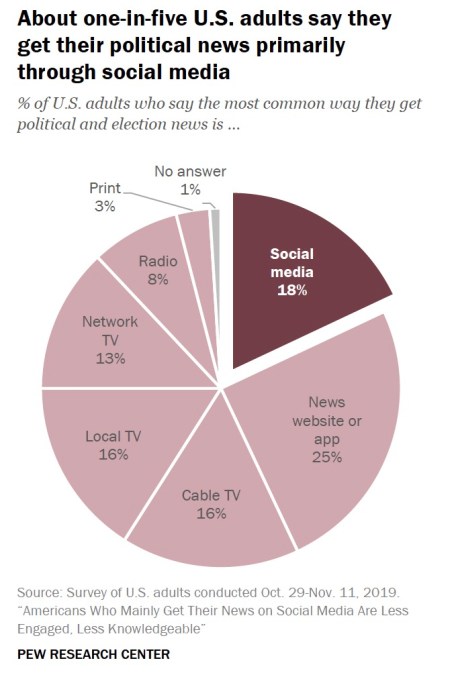
Image Credits: Pew Research
To be clear, any study that asks users to self-report how they do something isn’t going to be as useful as those that collect hard data on what the consumers actually do. In other words, people who think they’re getting most of their news from TV may be, in reality, undercounting the time they spent on social media — or vice versa.
That said, among this group of “primarily” social media news consumers, only 8% said they were following the key news story of the 2020 U.S. election “very closely,” compared with 37% of cable TV viewers who said the same, or the 33% of print users who also said this. The social media group, on this topic, was closer to the local TV group (11%).
On the topic of the coronavirus outbreak, only around a quarter (23%) of the primarily social media news consumers said they were following news of COVID-19 “very closely.” All other groups again reported a higher percentage, including those who primarily used cable TV (50%), national network TV (50%), news websites and apps (44%) and local TV (32%) for news.
Related to this finding, the survey respondents were also asked 29 different fact-based questions about news topics from recent days, including those on Trump’s impeachment, the COVID-19 outbreak and others. Those who scored the lowest on these topics were the consumers who said they primarily used social media to get their news.
Across nine questions related to foundational political knowledge, only 17% of primarily social media news consumers scored “high political knowledge,” meaning they got eight to nine of the questions right; 27% scored “middle political knowledge” (six-seven right) and 57% scored “low political knowledge” (five or fewer right.) The only group that did worse were those who primarily relied on local TV.
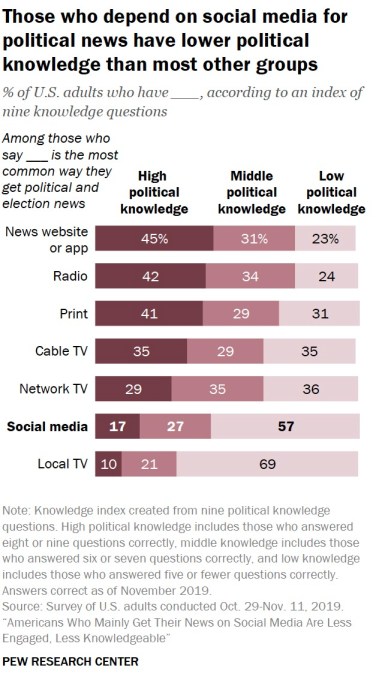
Image Credits: Pew Research
Also, 45% of those who got their news primarily via websites and apps, meanwhile, had “high political knowledge,” compared with 42% for radio, 41% for print, 35% for cable TV and 29% for network TV.
The social media group of news consumers was also more exposed to fringe conspiracies, like the idea that the pandemic was intentionally planned. Nearly a quarter (26%) of those who primarily got their news via social media said they had heard “a lot” about this conspiracy, and a sizable 81% said they had at least “a little.” This was significantly higher than all other news platforms, and a indication of how much conspiracies can spread across social media.
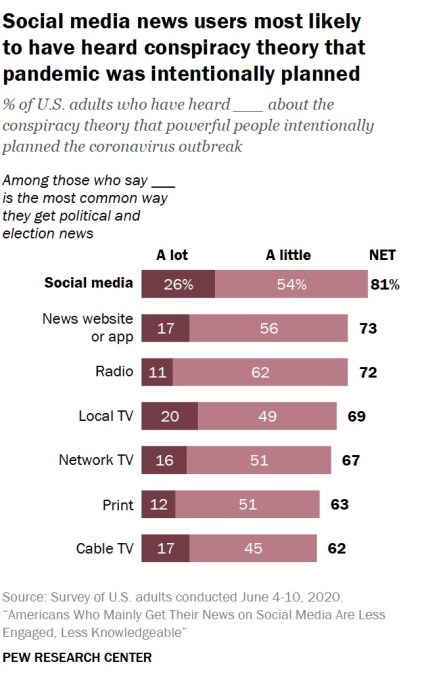
Image Credits: Pew Research
And yet, the same social media group reported they’re less concerned about the impact of made-up news. Only around four-in-ten (37%) said they were “very concerned” about the impact of made-up news on the 2020 elections, for example, which was lower than every other group except for local TV viewers (35%). Cable TV viewers had the most concern, at 58%.
More concerning, perhaps, is the power these conspiracies have to sway minds. Among those social media news consumers aware of the COVID-19 conspiracy, 44% who used social media to often get COVID-19 news said the theory was at least “probably true.” Only 33% of those who relied less on social media for COVID-19 news said the same.
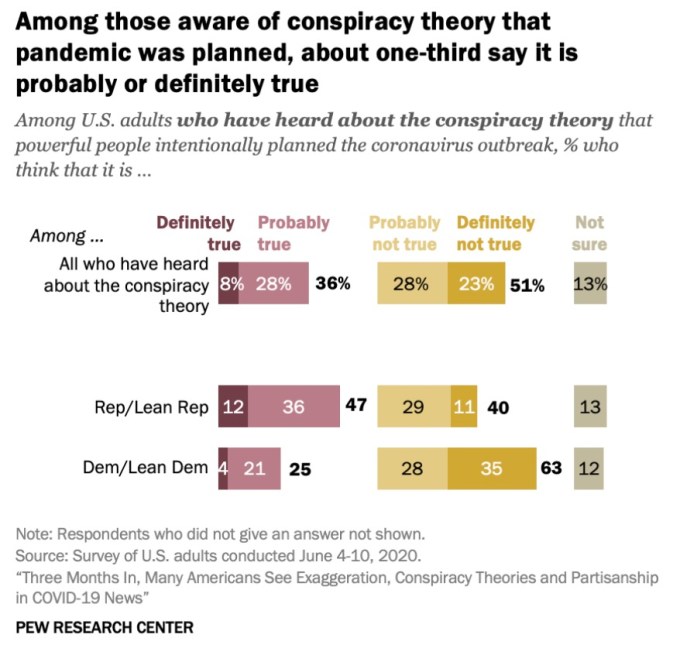
Image Credits: Pew Research
The study went on to compare social media news consumers’ knowledge of other topics, like COVID-19 impacts and related health news, with those who got their news from other sources, using similar methods. Again, the social media group came away with the least knowledgeable.
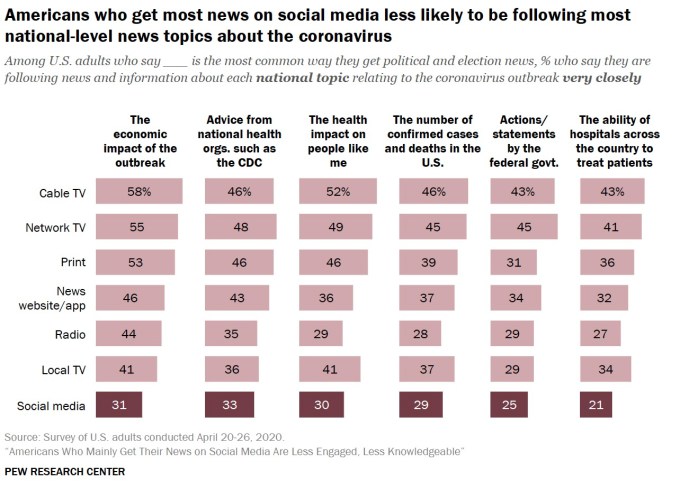
Image Credits: Pew Research
Pew’s conclusion from its research is that social media users are less informed, which seems fairly accurate on these specific topics. But the implication — or at least, what some people might take away from this report — is that they’re less informed because they rely on social media as their primary news source. That’s not necessarily true, given this data.
One issue with that conclusion has to do with social media demographics. The firm’s research also found that social media news consumers skewed young — 48% of those who mostly used social media for news were between 18 and 29, for example. They also tended to have lower levels of formal education, as only 26% had a college degree, versus 47% of those who read news websites or the 49% who turn to print. (Of course, this lack of higher education is likely, in part, tied to the fact that social media users skewed younger.)
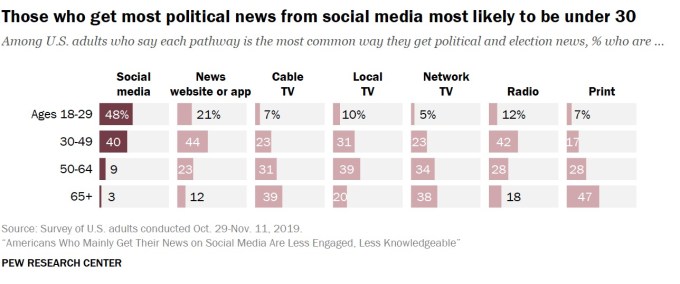
Image Credits: Pew Research
Historically, we know young people don’t engage with politics at the same level as older adults. They turn out at lower numbers during elections. They can be less engaged in their local politics because they’re relocating for college or for new jobs, because they haven’t made voting a habit and often miss registration deadlines. They may have had a poor education in civics to begin with and haven’t yet filled in the gaps the way older adults have. Many also feel alienated from politics. And so on.
On other topics, young people may also feel similarly distanced and disengaged. Many young adults have been unconcerned by the coronavirus outbreak, for example, thinking it only impacts older people, and carrying on as usual.
Their lack of knowledge, then, about the news may be due not to the platform where it’s consumed, but their interest and engagement with the topics in general.
Facebook’s Mark Zuckerberg appeared less than entirely truthful at today’s House Judiciary hearing, regarding last year’s major Onavo controversy, in which his company paid teenagers to use a VPN app that reported detailed data on their internet use. Though he may not have outright lied about it, his answers were evasive and misleading enough to warrant a rushed clarification shortly afterward.
Rep. Hank Johnson (D-GA) was asking Zuckerberg to confirm a series events last year first reported by TechCrunch: A VPN app called Onavo, owned by Facebook, was kicked out of Apple’s App Store for collecting and reporting usage data while purporting to provide a protective service.
Soon afterward, Facebook quietly began paying people — 18 percent of whom were teenagers — to install the “Facebook Research” app, which did much the same thing as Onavo under a different name. TechCrunch reported this and Apple issued a ban before the end of that day; Facebook claimed to have removed it voluntarily, but this was shown not to be true.
Rep. Johnson questioned Zuckerberg along these lines, and the latter repeatedly expressed his unsureness about and lack of familiarity with these issues.
Johnson: When it became public that Facebook was using Onavo to conduct digital surveillance, your company got kicked out of Apple’s App store, isn’t that true?
Zuckerberg: Congressman, I’m not sure I’d characterize it in that way.
Johnson: I mean, Onavo did get kicked out of the app store, isn’t that true?
Zuckerberg: Congressman, we took the app out after Apple changed their policies on VPN apps.
Johnson: And it was because of the use of the surveillance tools.
Zuckerberg: Congressman, I’m not sure the policy was worded that way or that it’s exactly the right characterization of it… [The policies are explained below.]
Johnson: Let me ask you this question, after Onavo was booted out of the app store, you turned to other surveillance tools, such as Facebook Research App, correct?
Zuckerberg: Congressman, in general, yes, we do a broad variety—
Johnson: Isn’t it true, Mr. Zuckerberg, that Facebook paid teenagers to sell their privacy by installing Facebook Research App?
Zuckerberg: Congressman, I’m not familiar with that, but I think it’s a general practice that companies use to, uh, have different surveys and understand data from how people are using different products and what their preferences are.
Johnson: Facebook Research app got thrown out of the App Store too, isn’t that true?
Zuckerberg: Congressman, I’m not familiar with that.
Of course, the idea that Zuckerberg was not familiar with events that made headlines, took down Facebook’s internal apps for days, and prompted an angry letter to him from a senator is absurd. (After all, Facebook responded.)
Perhaps intuiting that this particular claim of ignorance was a bridge too far (and perhaps in response to some frantic off-screen action in the CEO’s barnlike virtual testimony HQ), Zuckerberg took the opportunity to backpedal a few minutes later:
In response to Congressman Johnson’s question, before I said that I wasn’t familiar with the Facebook research app when I wasn’t familiar with that name for it. I just want to be clear that I do recall we used an app for research and it’s since been discontinued.
Of course, although Zuckerberg may plausibly have been unsure about the name, it’s not to be believed that he was not familiar with the events of that time, as they were both highly publicized and very costly for Facebook. Naturally he would also have been refreshed on them during preparation for this testimony.
That Zuckerberg is unfamiliar with the exact wording of Apple’s rules is possible, even probable, but it was no secret that the rules were changed basically in response to reports of Facebook’s Onavo shenanigans. Here is what Apple said at the time:
We work hard to protect user privacy and data security throughout the Apple ecosystem. With the latest update to our guidelines, we made it explicitly clear that apps should not collect information about which other apps are installed on a user’s device for the purposes of analytics or advertising/marketing and must make it clear what user data will be collected and how it will be used.
Later, when TechCrunch showed that Facebook had been using an enterprise deployment tool to essentially sideload spyware onto teenagers’ phones, Apple said this:
We designed our Enterprise Developer Program solely for the internal distribution of apps within an organization. Facebook has been using their membership to distribute a data-collecting app to consumers, which is a clear breach of their agreement with Apple. Any developer using their enterprise certificates to distribute apps to consumers will have their certificates revoked, which is what we did in this case to protect our users and their data.
So Facebook was the reason, implicitly first, then later explicitly, for these App Store lockdowns. Rep. Johnson put the whole thing quite plainly at the end of his questions.
Johnson: You tried one thing and then you got caught, made some apologies, then you did it all over again. [long pause]… Isn’t that true?
Zuckerberg: Congressman, I respectfully disagree with that characterization.
You can watch the full hearing here:
In one of the first substantive moments at Wednesday’s major tech hearing, Facebook’s 2012 acquisition of Instagram came under fire, unearthing a few new revelations about the company’s internal thinking at the time.
Alluding to new documents provided to the committee as part of its ongoing year-long antitrust investigation, House Judiciary Committee Chairman Jerry Nadler said emails between Mark Zuckerberg and other Facebook executives at the time tell “a very disturbing story.”
Nadler went on to declare that Facebook’s acquisition of Instagram violated antitrust laws. “If this was an illegal merger at the time of the transaction, why shouldn’t Instagram now be broken off into a separate company?” Nadler asked.
In a video question and answer session on April 6, 2012 — three days before announcing the Instagram acquisition — Zuckerberg describes the threat posed by the social photo-sharing app, mentioning Facebook’s own “not awesome” mobile app that users only “tolerate”:
They’re growing well. We need to dig ourselves out of a hole. The good news is, we’ve been doing that. The bad news is that they are growing really quickly, they have a lot of momentum and it’s kind of going to be tough to dislodge them. We have a hard battle ahead of ourselves there.
In emails obtained by the committee, Nadler quotes Zuckerberg saying “one thing about startups is you can often acquire them” — and beginning with Instagram, Facebook has certainly done that. A number of those correspondences were reported by The Verge prior to the committee making them available broadly.
“I’ve always been clear that we viewed Instagram as both a competitor and as a complement to our services,” Zuckerberg said Wednesday, defending the company and downplaying Nadler’s critiques.
“At the time, almost no one thought of them as a general social network,” Zuckerberg claimed.
The reality is that Instagram was already wildly popular, with more than 100,000 daily downloads in Apple’s App Store. “At 27 million registered users on iOS alone, Instagram was increasingly positioning itself as a social network in its own right — not just a photo-sharing app,” TechCrunch’s Sarah Perez wrote at the time.
Given the climate of the deal, the House Judiciary chairman threatened that unwinding the merger would be appropriate, even eight years later.
“… Facebook saw Instagram as a powerful threat that could siphon business away from Facebook so rather than compete with it, Facebook bought it,” Nadler said.
“This is exactly the same kind of anticompetitive action that the antitrust laws were designed to prevent.”
Twitter has temporarily frozen Donald Trump Jr.’s account after the president’s son shared a video making false and potentially life-threatening claims about the coronavirus pandemic.
The younger Trump’s account was restricted Tuesday morning after he shared a link to the viral video, tweeting “This is a much [sic] watch!!! So different from the narrative that everyone is running with.”
“The Tweet referenced was in violation of our COVID-19 misinformation policy,” a Twitter spokesperson told TechCrunch. The company said that the tweet violated its rules against COVID-19 misinformation and must be deleted. Trump’s account was not suspended, but its functionality will be restricted for 12 hours.
This account has not been permanently suspended. Per the screenshot, the Tweet requires deletion because it violates our rules (sharing misinformation on COVID-19), and the account will have limited functionality for 12 hours. More in our rules: https://t.co/0wHWVV5QS4 https://t.co/0gq7rlaNw7
— Twitter Comms (@TwitterComms) July 28, 2020
The video was widely publicized by Breitbart News and features a number of people in lab coats who refer to themselves as “America’s Frontline Doctors.” In the video, the individuals push various false and dangerous claims, including the claim that masks don’t prevent the spread of the virus and yet another defense of the drug hydroxychloroquine, which hasn’t proven effective in treating the virus.
Stella Immanuel, one figure central to the video, has made outlandish unscientific claims in the past, the Daily Beast’s Will Sommer reports. Those claims include the assertion that “alien DNA” is currently in use for some medical treatments and that some gynecological problems are a result of a patient having sex with demon-like “spirit husbands” and “spirit wives.”
President Trump shared the video multiple times on Monday night in tweets that now appear as “no longer available” on his timeline. The now-removed tweets are wedged in between a number of remaining retweets that defend hydroxychloroquine as a “gold standard” and a “game changer.” The retweets also attack White House pandemic advisor Dr. Anthony Fauci’s credibility.
Facebook and YouTube are also working to scrub instances of the viral video. On Facebook, it collected more than 14 million views and became one of the platform’s most popular posts before the company took action to remove it.
On the back of a major security breach last week that saw a bitcoin scam ripple through some of the highest profile accounts on Twitter, the company today reported Q2 earnings that point to the ongoing struggle for ad-based social platforms to weather the pandemic storm while (ironically) handling record levels of traffic and the many growing pains that come with that.
Revenues came in at $683 million with a loss per share (GAAP) of $0.01, with both figures down on the same quarter a year ago, compared to analysts’ expectations, and on Twitter’s own guidance. Meanwhile mDAUs — Twitter’s own audience metric denoting monetizeable daily active users — reached a high of 186 million for the quarter.
Analyst consensus was for $700 million in sales, while Twitter expected a 27% higher figure. Adjusted EPS, meanwhile, was negative $0.16 (non-adjusted was negative $1.56), while analysts expected negative $0.01. For some context, in the same quarter a year ago Twitter reported revenues of $841 million on adjusted EPS of $0.20.
A further note on Twitter’s diluted EPS of negative $1.56: it stemmed from a net loss of $1.2 billion, and Twitter explained that this was in part due to a deferred tax asset valuation allowance of $1.1 billion and a non-cash income tax expense based primarily on cumulative taxable losses “driven primarily by COVID-19.”
The numbers underscore just how much advertising — which accounts for the majority of Twitter’s revenues — has taken a hit for the company despite the continuing surge of traffic and popularity for the site itself. That mDAU figure not only bettered Twitter’s figures last year of 139 million, but beat analysts’ average expectation of 173 million.
Advertising specifically accounted for $562 million of its revenues, down 23% on a year ago. Twitter noted that the pandemic and “civil unrest” that led to many advertisers pausing campaigns both contributed to the decline. The U.S., Twitter’s biggest market, saw a decline of 25% in ad spend.
It goes to show the disconnect not only between audience and advertising that still seems to exist — ads ultimately not only follow eyeballs, but the economy, and that has been in decline — but also the disconnect between financials and how a company is discussed in popular discourse.
That is to say, the big story with Twitter in the last three months has been the ongoing questions of quality, health and security on the platform, and how and whether should Twitter disable bad actors while still upholding free speech. That debate will continue for a long time to come, not just on Twitter but in the halls of government in the months ahead.
It’s that focus on improving the product that CEO Jack Dorsey focused on in his statement on this past quarter’s performance.
“Our product work is paying off, with tremendous growth in audience and engagement,” he said. “We grew mDAU to 186 million, a 34% year over year increase in Q2, the highest quarterly year-over-year growth rate we’ve delivered since we began reporting mDAU growth.
“I also want to address the security issue Twitter suffered last week. We moved quickly to address what happened, and have taken additional steps to improve resiliency against targeted social engineering attempts, implemented numerous safeguards to improve the security of our internal systems, and are working with law enforcement. We understand our responsibilities and are committed to earning the trust of all of our stakeholders with our every action, including how we address this security issue. We will continue to be transparent in sharing our learnings and remediations.”
Ned Segal, the CFO, noted that the ad server rebuild should also help the company recover going forward.
“Despite the pandemic, brands have found innovative ways to join the conversation on Twitter to connect with their customers,” he said. “We have completed our ad server rebuild and are making progress accelerating our performance ads roadmap. With a larger audience and progress in ads, we are even better positioned to deliver for advertisers when the live events and product launches that bring many people and advertisers to Twitter return to our lives.”
More to come.
After reporting Q2 earnings that showed a marked dip in ad revenue, Twitter has said its exploring alternatives — dangling the possibility of a subscription option.
Earlier today the social media giant reported ad revenues of $562M, down almost a quarter (23%) on a year ago — saying that the pandemic and “civil unrest” leading many advertisers to pause campaigns had both contributed to the decline. While the US, its biggest market, saw a drop of 25% in ad spend.
Twitter CEO Jack Dorsey told investors it’ll likely run subscription “tests” this year (via CNN), though he also said the bar for charging users for aspects of the service would be set “really high”.
So presumably it’s not considering a ‘your first ten tweets are free’ style pay-to-tweet model.
“We want to make sure any new line of revenue is complementary to our advertising business,” CNN reports Dorsey remarking during the investor call. “We do think there is a world where subscription is complementary, where commerce is complementary, where helping people manage paywalls… we think is complementary.”
The prospect of a paid version of Twitter — free from trackers, annoying ads and irritating algorithms which meddle with the clean chronology of the timeline — has been a holy grail for certain Twitter addicts since (basically) forever. So plenty of its most fervent users will be watching keenly to see exactly what Dorsey cooks up.
We’re spitballing here — but perhaps Twitter could charge, er, certain high profile, high risk users billions of dollars per month for the privilege of tweet-threatening the rest of humanity… Just a thought.
Twitter casting around for ad revenue diversification looks interesting in light of broader digital privacy trends that have put the ad tracking industry under increasing (and increasingly awkward) scrutiny.
Certain adtech players and mechanisms are facing challenges under European data protection rules, for instance, while there are also moves afoot in California to further tighten the consumer protections introduced this year, under the Consumer Privacy Act, which could see more US users blocking the tracking industry’s access to their data.
Last week’s massive Twitter security breach also hardly throws a positive light on the company from a privacy perspective. Dorsey addressed the breach in remarks on today’s call, with CNN reporting he apologized to investors — admitting the company “fell behind” on its security obligations.
TikTok today announced a $200 million fund, aimed at helping top creators in the U.S. supplement their earnings, and potentially coax the next Charli D’Amelio out of the woodwork.
Called the TikTok Creator Fund, the money is aimed at helping “eligible” creators on the platform earn a livelihood, it said. Eligible for now is defined as 18 years or older, meeting a certain (unspecified) baseline for followers, and consistently posting original content that is in line with TikTok’s community guidelines. The platform will begin accepting applications from U.S.-based creators starting next month and distribute the capital over the coming year.
The promise of payouts is coming at a key moment for the app and its Chinese parent ByteDance. TikTok has been facing mounting criticism in the US, its biggest market by revenues, over how it handles user data and its ties to China, with calls from the Trump administration to ban the popular app outright.
And in response to that, TikTok has been making moves to present a more friendly face to the US. It has pledged to add 10,000 more staff in the US, and this week rumors began to circulate that investors in the US are considering buying a majority stake in the TikTok business back from ByteDance to establish control of the company out of China’s hands.
(It’s not clear if the latter is testing the waters of sentiment, or just an outright rumour, but as an aside to that, these days, ByteDance and TikTok try to go to great lengths to show they are not connected, if you go by how they handle their PR: Chinese spokespeople will not answer TikTok questions and refer journalists to the US team.)
Vanessa Pappas, GM of TikTok’s U.S. business, said in a blog post that ByteDance is starting the Creator Fund at $200 million and plans to increase it over time. She did not disclose how TikTok would decide what sum would be paid to an individual creator, and whether there would be any additional conditions to getting a payout. (We have asked about this and how many followers creators might need to have to be eligible, and will update as we learn more.)
TikTok already helps its creators sign brand partnerships and sponsorship deals, and it provides monetization for live-streams. The platform also has a $50 million Creative Learning Fund to introduce teachers to the platform, which has been used by some 1,000 teachers in the U.S. already. And a Creator Marketplace connects brands to creators to collaborate on paid campaigns.
“Through the TikTok Creator Fund, our creators will be able to realize additional earnings that reflect the time, care, and dedication they put into creatively connecting with an audience that’s inspired by their ideas,” she said.
TikTok currently employs about 1,400 people in the U.S. and recently crossed the milestone of 2 billion installs globally. Last year, it said it had 26 million users in the U.S.
Several lawmakers including Senators Chuck Schumer and Tom Cotton have expressed concerns in recent months that TikTok’s user data could end up with the Chinese government. China-headquartered ByteDance insists that it does not share any user’s data with the Chinese government, and that it stores its U.S.-based user data in the U.S. and Singapore. Earlier this week House lawmakers voted 336-71 to bar federal employees from using TikTok on government-issued devices.
TikTok, which appointed Disney streaming executive Kevin Mayer as its chief executive officer in May this year, also insists that it is a Cayman Islands incorporated firm.
For now, it seems that the programs that TikTok is launching are squarely aimed at fighting that fire in the US. It did not respond to a request for comment asking what it was doing to help creators in other markets supplement their earnings.
India, where TikTok has more than 200 million users and over 1 million creators, banned TikTok and 58 other apps developed by Chinese firms late last month over cybersecurity concerns. Its neighboring nation Pakistan issued a “final warning” to TikTok earlier this week over what it deemed “immoral, obscene, and vulgar content.”
Zoom has run away with the prize in the last few months for becoming the video calling platform of choice for people confined to their homes, whether they are making work calls or friend calls. No one really talks about “Teamsing up” (“Skyping,” perhaps?), or “Hangoutsing” or “Meeting“, or indeed “Roomsing.” But many people talk about Zooming, even when they’re not using Zoom to do it.
Today Facebook added in a new feature to its own contribution to the video chat landscape that should lead, if not immediately to more usage, more engagement when Messenger Rooms does get used.
The social network has announced that people using Messenger Rooms — the video chat software that lets people create calls with up to 50 people via a link (no Facebook or Messenger account required to join the call) — can now choose to broadcast that Rooms chat to Live, the feature in Facebook that lets people broadcast directly through Groups, Pages and in timelines via your Profile.
Facebook Rooms via Live will still come with controls for the call host: the limit is 50 people, users need a link to join, and the moderator/call host can still remove people if needed.
The difference now is that those calls will essentially be carried out on a stage, seen by as many as would have seen a Live broadcast posted by that host. When the room goes “Live”, participants will have to opt-in to be a part of it, and they can also leave before it starts to broadcast.
Messenger Rooms was first announced as “Rooms” in a limited rollout at the end of April. Seen by some initially as a Houseparty competitor, it was launched was a time when the world was well into numerous shelter-in-place orders to try to stem the spread of the global health pandemic caused by the novel coronavirus and were turning to video conferencing as a way to stay connected.
Amid many alternatives, Zoom had quickly emerged as the most popular way for people to do that, albeit, not without lots of controversy, partly due to the fact that this enterprise company had never in its wildest dreams thought it would take off as a consumer product and get used by a billion people. Meanwhile, Rooms was then rolled out globally as Messenger Rooms in June.
Because of the controversies Zoom faced, and because Facebook is, well, Facebook, it didn’t really matter at first how well Messenger Rooms was picking up traction: the message was that Zoom should be worried.
It’s actually not clear how many people are now using Messenger Rooms. (We’ve reached out to Facebook to ask.) Nor is it even clear if Facebook ultimately finds Zoom a threat.
Today’s news, it seems, is about adding more incremental engagement across Facebook overall, and adding in features that already exist for the de facto leader in the market.
You can already stream a Zoom call on Facebook Live, so why not be able to stream a Messenger Rooms call live there too? (I don’t know if Facebook will extend that to the other places where Zoom can stream, which include YouTube and Twitch.)
Facebook said that the feature is getting rolled out in limited release today and will soon expand globally to everywhere that Messenger Rooms works. Facebook also says this is a work in progress, with other news features coming soon, too.
Last week’s hack of over 100 very high-profile Twitter accounts did in fact expose the direct messages of many of those accounts, the company admitted today — including those of an elected official in the Netherlands, Geert Wilders.
The attack saw numerous popular accounts of celebrities and politicians taken over and tweeting a very obvious Bitcoin scam that nevertheless seems to have netted at least six figures. Twitter said that a “coordinated social engineering attack” gave hackers “access to internal systems and tools.” Verified users were also briefly prevented from tweeting (a change some welcomed).
In tweets and an update to its blog post on the “security incident,” Twitter said that “for up to 36 of the 130 targeted accounts, the attackers accessed the DM inbox.” They are “actively working on communicating directly” with those accounts affected.
We believe that for up to 36 of the 130 targeted accounts, the attackers accessed the DM inbox, including 1 elected official in the Netherlands. To date, we have no indication that any other former or current elected official had their DMs accessed.
— Twitter Support (@TwitterSupport) July 22, 2020
Twitter had declined to say in the immediate aftermath of the attack whether DMs had been accessed by the hackers. Twitter’s messaging system is infamously not well encrypted but it was not clear whether the administrative tool reportedly used by the attackers offered access to inboxes.
Apparently whatever method was used, it gave access to DMs some of the time, or perhaps the hackers simply didn’t avail themselves of the opportunity for the remaining 94 accounts they took over. It’s not really clear from Twitter’s announcement. Twitter has previously said that it has “no evidence” that passwords were accessed by the hackers, and nothing in the update contradicts that.
The company’s attempted to place a silver lining on this cloud, saying it had “no indication that any other former or current elected official had their DMs accessed.” Considering the accounts of Barack Obama and Joe Biden were among those affected, that is technically good news.
This is almost certainly not the last we’ll hear from Twitter on this disturbing security breach.
Facebook is testing a new design for Facebook Pages that will, among other things, remove the “Like” count, offer a cleaner and more readable layout, and make it easier for those who operate Pages to actually use and manage them. These features and others were initially tested with a small percentage of public figures on the mobile app, but are now being expanded to a broader group of Pages.
Currently, the public figures involved in the test include actors, authors, creators, and a small handful of media entities, like bands and books. If included in the test, the Pages will see an option to opt in to try out the new experience when they’re logged in on mobile.
Facebook says it’s now expanding the test now to include a small percentage of English-language business Pages, as well.
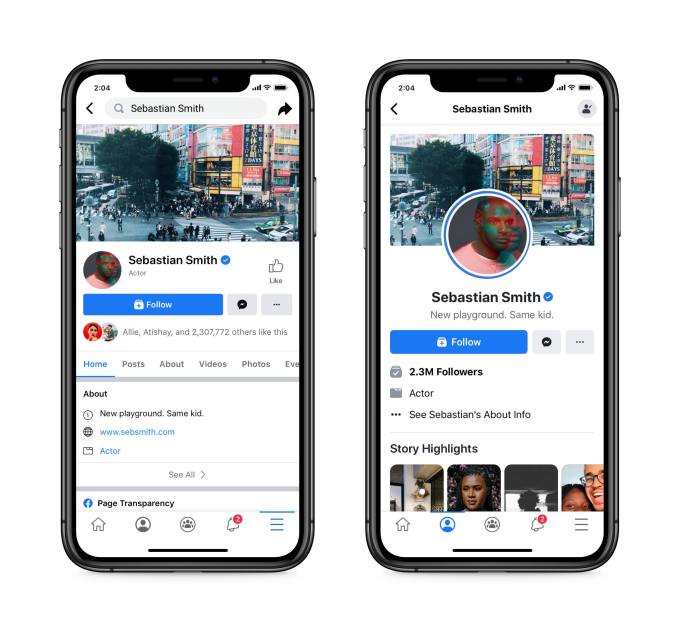
Image Credits: Facebook (Old vs New Pages)
The updated design and feature set is meant to make using Pages less complex, something the company understands can be an issue. It also acknowledges the need to simplify the use of Pages now, in particular, with so many people continuing to practice social distancing and choosing to instead connect with their communities online.
The new Page layout is meant to make it easier for visitors to a Page see key information, like the Page’s bio and posts. Notably, the design does away with the Page Likes and the Like button. Instead, the Page will only display a Follow button and follower count.
This change better reflects the Page’s true reach. Many people have “Liked” various Pages over the years, but then unfollowed them from their News Feed as they outgrew their interest. (Or they unfollowed them because they were only liking the Page as a favor, after being sent a request, for example.) The Follows count, meanwhile, indicates how many people are actually receiving the Page’s update in their News Feed.
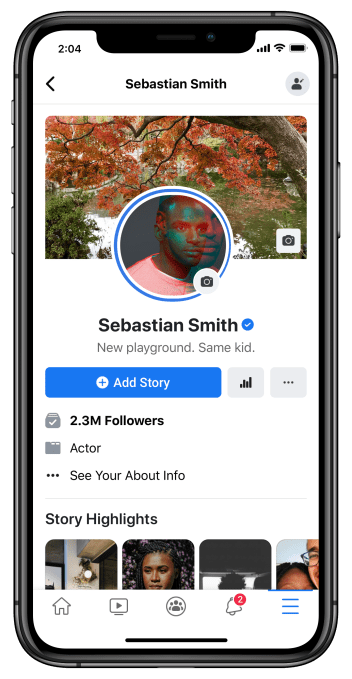
Image Credits: Facebook
Having both options has lead to a more complicated process where users first “like” a Page, which creates an automatic follow. But the person can then back out of that follow by changing their settings at any time. Page owners find this to be confusing and unhelpful because they want to engage with followers who are actually interested in the Page and its contents.
In addition, Page owners will be able to better connect with followers by browsing their News Feed, and then quickly switch between their personal Facebook profile and the public-facing Page (or Pages) they manage when they want to comment or react to posts they come across.
On the Page management side, they’ll be able to more clearly assign and manage admin access permissions based on specific tasks. This will be handled by an updated “Edit Access” screen, where owners can toggle on and off specific management tasks, like who can create Page content, send direct messages as the Page. create ads, respond to comments, and more.
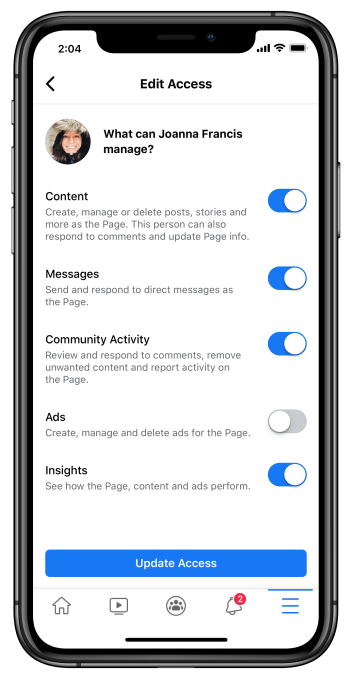
Image Credits:
The update additionally aims to make it simpler to navigate to the Page Insights section, which is where Page owners and managers track analytics related to the Page’s performance.
Now, Page owners will be able to get to these insights from the Page itself or even directly from a post. Within the Insights section, they’ll gain access to a handful newly added insights, as well, including top performing posts and a new metric that shows the Page’s audience overlap with its connected Instagram account.
They’ll receive fewer notifications from their Pages, too, as Facebook will now group together relevant and related data, like mentions and post reactions, when sending updates.
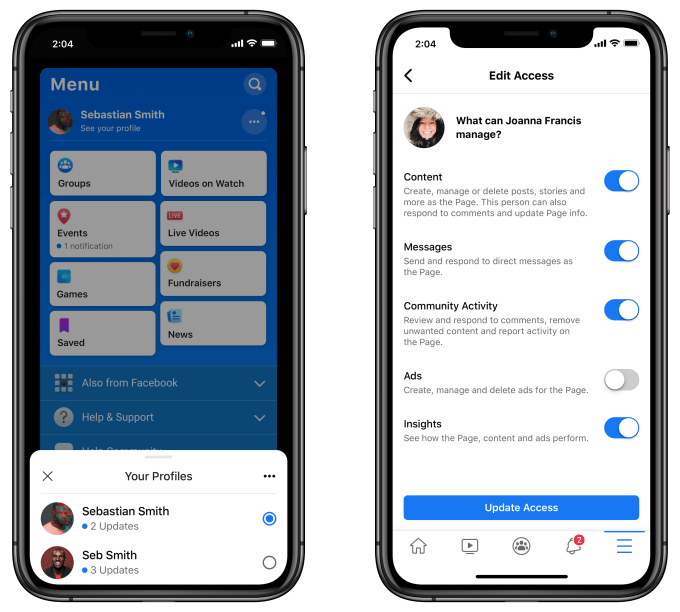
Image Credits: Facebook
The test is running now in the Facebook mobile app but it’s not limited only to those who are seeing the simplified app design (pictured here with the colorful blue background and boxes.)
Facebook isn’t sharing when the update will roll out more broadly as this is still considered a test for the time being.
Twitter announced Tuesday that many accounts spreading the pervasive right-wing conspiracy theory known as QAnon would no longer be welcome on its platform.
Citing concerns about “offline harm,” the company explained that it would begin treating QAnon content on the platform differently, removing related topics from its trending pages and algorithmic recommendations and blocking any associated URLs. Twitter also said that it would permanently suspend any accounts tweeting about QAnon that have previously been suspended, coordinate harassment against individuals or amplify identical content across multiple accounts.
We will permanently suspend accounts Tweeting about these topics that we know are engaged in violations of our multi-account policy, coordinating abuse around individual victims, or are attempting to evade a previous suspension — something we’ve seen more of in recent weeks.
— Twitter Safety (@TwitterSafety) July 22, 2020
Twitter says the enforcement will go into effect this week and that the company would continue to provide transparency and additional context as it makes related platform policy choices going forward. According to a Twitter spokesperson, the company believes its action will affect 150,000 accounts and more than 7,000 QAnon-related accounts have already been removed for breaking the rules around platform manipulation, evading a ban and spam.
QAnon emerged in the Trump era and the conspiracy’s adherents generally fervently support the president, making frequent appearances at his rallies and other pro-Trump events. QAnon’s supporters believe that President Trump is waging a hidden battle against a secretive elite known as the Deep State. In their eyes, that secret battle produces many, many clues that they claim are encoded in messages sprinkled across anonymous online accounts and hinted at by the president himself.
QAnon is best known for its connection to Pizzagate, a baseless conspiracy that accused Hillary Clinton of running a sex trafficking ring out of a Washington D.C. pizza place. The conspiracy inspired an armed believer to show up to the pizza shop, where he fired a rifle inside the restaurant, though no one was injured.
While the conspiracy theory is elaborate, odd, and mostly incoherent, it’s been popping up in other mainstream places. Last week, Ed Mullins, the head of one of New York City’s most prominent police unions, spoke live on Fox News with a mug featuring the QAnon logo within clear view of the camera. In Oregon, a QAnon supporter won her primary to become the state’s Republican nominee for the Senate.
Bangladesh’s regulator has ordered telecom operators and other internet providers in the nation to stop providing free access to social media services, becoming the latest market in Asia to take a partial stand against zero-rating deals.
Bangladesh Telecommunication Regulatory Commission, the local regulator, said late last week that it had moved to take this decision because free usage of social media services had spurred their misuse by some people to commit crimes. Local outlet Business Standard first reported about the development. Bangladesh is one of the largest internet markets in Asia with more than 100 million online users.
Technology companies such as Facebook and Twitter have struck partnerships, more popularly known as zero-rating deals, with telecom operators and other internet providers in several markets in the past decade to make their services free to users to accelerate growth. Typically, tech companies bankroll the cost of data consumption of users as part of these deals.
In Bangladesh, such zero-rating deals have been popular for several years, said Ahad Mohammad, chief executive of Bongo, an on-demand streaming service, in an interview with TechCrunch (Extra Crunch membership required) .
Grameenphone and Robi Axiata, two of the largest telecom operators in Bangladesh, enable their mobile subscribers to access a handful of services of their partners even when their phones have run out of credit. Both telecom firms have said they are in the process to comply with Dhaka’s order.
It remains unclear whether Free Basics, a program run by Facebook in dozens of markets through which it offers unlimited access to select services at no cost, will continue its presence in Bangladesh after the nation’s order. Facebook relies on telecom networks to offer data access for its Free Basics program.
In Bangladesh, Facebook struck deals with Grameenphone and Robi Axiata, according to its official website, where Facebook continues to identify Bangladesh among dozens of markets where Free Basics is operational.
Several nations in recent years have balked at zero-rating arrangements — though they have often cited different reasons. India banned Free Basics in early 2016 on the grounds that Facebook’s initiative was violating the principles of net neutrality.
Free Basics also ended its program in Myanmar and several other markets in 2017 and 2018. Facebook did not respond to requests for comment.